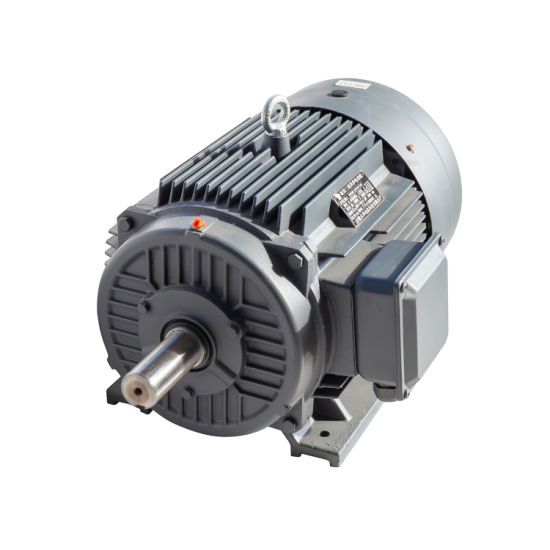QINGDAO ENNENG MOTOR CO.,LTD. |
|
Verified Suppliers
|
|
Liquid Cooled Long Service Life Permanent Magnet Motor
What Is The Permanent Magnet Synchronous Motor?
The liquid cooled permanent magnet motor is a type of electric motor that utilizes permanent magnets for its operation, and it incorporates a liquid cooling system to manage the heat generated during its operation.
Working Principles
The liquid-cooled permanent magnet motor operates based on the laws of electromagnetism. Its construction includes a rotor fitted with permanent magnets and a stator carrying copper windings. When electricity is supplied to the stator windings, it generates a rotating magnetic field which interact with the permanent magnets on the rotor, propelling it into rotation.
Distinct from other types of motors that rely on electromagnets on the rotor, the permanent magnet motor has fixed magnets installed in the rotor. These magnets are typically made from rare-earth materials such as neodymium or samarium cobalt, which offer powerful magnetic fields and high energy density.
The liquid cooling system in a liquid-cooled permanent magnet motor is designed to dissipate the heat generated during operation. Typically, a coolant such as water or a mixture of water and glycol is circulated around the motor, either directly through channels in the stator or indirectly through a heat exchanger. This circulation of coolant helps maintain optimal operating temperatures, preventing overheating, and ensuring the motor’s efficient performance as well as its longevity.

Why choose permanent magnet ac motors?
Permanent magnet AC (PMAC) motors offer several advantages over other types of motors, including:
High Efficiency: PMAC motors are highly efficient due to the absence of rotor copper losses and reduced winding losses. They can achieve efficiencies of up to 97%, resulting in significant energy savings.
High Power Density: PMAC motors have a higher power density compared to other motor types, which means they can produce more power per unit of size and weight. This makes them ideal for applications where space is limited.
High Torque Density: PMAC motors have a high torque density, which means they can produce more torque per unit of size and weight. This makes them ideal for applications where high torque is required.
Reduced Maintenance: Since PMAC motors have no brushes, they require less maintenance and have a longer lifespan than other motor types.
Improved Control: PMAC motors have better speed and torque control compared to other motor types, making them ideal for applications where precise control is required.
Environmentally Friendly: PMAC motors are more environmentally friendly than other motor types since they use rare earth metals, which are easier to recycle and produce less waste compared to other motor types.
Overall, the advantages of PMAC motors make them an excellent choice for a wide range of applications, including electric vehicles, industrial machinery, and renewable energy systems.
Application:
The liquid-cooled permanent magnet motor is an electric motor variant that utilizes permanent magnets in the rotor while incorporating a liquid cooling system to ensure optimal operating temperatures. This design offers numerous advantages, including higher power densities, consistent performance, and suitability for various industries and applications.
Permanent magnet synchronous motors with internal magnets: Maximum energy efficiency
The permanent magnet synchronous motor with internal magnets (IPMSM) is the ideal motor for traction applications where the maximum torque does not occur at maximum speed. This type of motor is used in applications that require high dynamics and overload capacity. And it is also the perfect choice if you want to operate fans or pumps in the IE4 and IE5 range. The high purchase costs are usually recouped through energy savings over the run time, provided that you operate it with the right variable frequency drive.
Our motor-mounted variable frequency drives use an integrated control strategy based on MTPA (Maximum Torque per Ampere). This allows you to operate your permanent magnet synchronous motors with maximum energy efficiency. The overload of 200 %, the excellent starting torque, and the extended speed control range also allow you to fully exploit the motor rating. For fast recovery of costs and the most efficient control processes.
Permanent magnet synchronous motors with external magnets for classic servo applications
Permanent magnet synchronous motors with external magnets (SPMSM) are ideal motors when you need high overloads and rapid acceleration, for example in classic servo applications. The elongated design also results in low mass inertia and can be optimally installed. However, one disadvantage of the system consisting of SPMSM and variable frequency drive is the costs associated with it, as expensive plug technology and high-quality encoders are often used.
Self-sensing versus closed-loop operation
Recent advances in drive technology allow standard ac drives to “self-detect” and track the motor magnet position. A closed-loop system typically uses the z-pulse channel to optimize performance. Through certain routines, the drive knows the exact position of the motor magnet by tracking the A/B channels and correcting for errors with the z-channel. Knowing the exact position of the magnet allows for optimum torque production resulting in optimum efficiency.
PM Motor Structure

Flux weakening/intensifying of PM motors
Flux in a permanent magnet motor is generated by the magnets. The flux field follows a certain path, which can be boosted or opposed. Boosting or intensifying the flux field will allow the motor to temporarily increase torque production. Opposing the flux field will negate the existing magnet field of the motor. The reduced magnet field will limit torque production, but reduce the back-emf voltage. The reduced back-emf voltage frees up the voltage to push the motor to operate at higher output speeds. Both types of operation require additional motor current. The direction of the motor current across the d-axis, provided by the motor controller, determines the desired effect.